Here we bring new water
from the well so clear,
For to worship God with,
this happy New Year.
Sing levy dew, sing levy dew,
the water and the wine;
The seven bright gold wires
and the bugles that do shine.
Sing reign of Fair Maid,
with gold upon her toe, -
Open you the West Door,
and turn the Old Year go.
Sing reign of Fair Maid
with gold upon her chin, -
Open you the East Door,
and let the New Year in.
Sing levy dew, sing levy dew,
the water and the wine;
The seven bright gold wires
and the bugles they do shine
Unknown, A New Year Carol
Hello, and welcome to this last Bracken & Wrack newsletter of 2023.
A very happy Full Moon in Cancer to you. Soon it will be time for a New Year to sweep in, with all its dreams of fresh hope and inspiration.
As flames flicker, casting light and shadow onto the still barren land with its bleached and sodden stems, something stirs. Stories, like seeds, stretch in the warming earth and break the surface one by one. Who can say what will emerge?
If you’d like to join our band of pilgrims, you are so welcome here. Lace on your stoutest boots, grab your staff, sling a knapsack of provisions on your back and let’s set out along the path.
My willow staff resting against the ruined Bromholm Priory gatehouse, Norfolk.
In this edition:
A Blessing for a New Beginning
Steering by the Stars
Walking to the Well
God’s Kitchels
A Blessing for a New Beginning
In out-of-the-way places of the heart,
Where your thoughts never think to wander,
This beginning has been quietly forming,
Waiting until you were ready to emerge.
For a long time it has watched your desire,
Feeling the emptiness growing inside you,
noticing how you willed yourself on,
Still unable to leave what you had outgrown.
It watched you play with the seduction of safety
And the grey promises that sameness whispered,
Heard the waves of turmoil rise and relent,
Wondered would you always live like this.
Then the delight, when your courage kindled,
And out you stepped onto new ground,
Your eyes young again with energy and dream,
A path of plenitude opening before you.
Though your destination is not yet clear
You can trust the promise of this opening;
Unfurl yourself into the grace of beginning
That is at one with your life’s desire.
Awaken your spirit to adventure;
Hold nothing back, learn to find ease in risk;
Soon you will be home in a new rhythm
For your soul senses the world that awaits you.
John O’Donohue, ‘Blessing for a New Beginning’, Benedictus
Over the past year at Bracken & Wrack we’ve looked at an array of alternative names for every full moon. Feeling into the landscape and seasonal conditions here in Norfolk I’ve pondered the names that I might give each Moon myself, and invited you to do the same. Sometimes I’ve discovered things that I’ve just had to include in this section too, like the traditions around a Blue Moon or what a Super Moon actually is. When this happens again, as I’m sure it will, I will definitely share them with you.
One springs to mind already. Did you know that, since today’s Cold Moon is the full moon nearest the midwinter solstice, it takes a higher path than any other along the top of the sky? Apparently this means that it’s visible for longer than other full moons though I’ve yet to look up exactly how this works.
Of course you’re very welcome to go back through my old full moon newsletters and marvel at the myriad names that have, at one time or another, greeted each lunar cycle. But in recognition that we are about to turn the page into 2024, it felt like a good time to begin a new series. Episode One at the next full moon will be about Orion.
But for now …
Twelfth Night approaches, and the Magi follow a Star.
I love watching the night sky, but am definitely no expert on the stars in any scientific sense. In fact, in some ways I prefer to keep my observations on a mystical level rather than knowing the facts and figures which to me, sometimes flatten out the magic a little. Having said that, some of the astronomical statistics are so astounding that I’m sure they’ll wriggle their way in somewhere.
In general though, I prefer to let wonder rule the roost.
Among others, I already know I’ll be drawing on the wisdom of Claire Nahmad in Earth Magic and of Nigel G Pearson in Walking the Tides, and no doubt flinging in any snatches of folklore and whimsy and fantastical fact I pick up along the way.
As someone who loves words, for me one of the most magical aspects of stargazing is discovering the names of the individual asteroids. Not just knowing what they are but speaking them out loud, as in a spell. Or even better, whispering them.
As ever, Hilary Llewellyn-Williams has come up with exactly the right poem in our moment of need. I can think of no better way to begin our series than to invoke the power and mystery of the heavens with her words. If you try reading them out loud you’ll see what I mean.
Pegasus (ledger slab rubbing), Salle church, Norfolk.
Steering by the Stars
Nobody steers by starlight any more:
we’re too clever for that
we’ve packed the stars away
in the dusty dark
turned the key in the lock.
Eyes down, we study our instruments
measuring our location
without benefit of heaven
the beasts above us, the ones
with fiery faces
blotted out by light.
We have banished night from the world
who needs it? It belongs
out there with the past
with the star names
of the Magi, who saw
the eyes of the Bull and said:
Aldebaran, Elnath.
Dubhe, they said, and Alioth
and Albaid, the haunches of the Bear.
From the East, a long slow caravan
sets out across the desert
ships navigate the wastes
of the open ocean
and in the empyrean a blaze
of beings journeying
along with them, and Pegasus
is beating his four wings:
Scheat, Markah, Algenih, Alpheratz.
Heroes of old, the Archer
his bow stretched Nunki to Kaus
and the Hunter with the jewels
in his belt: Alnilam,
Rigel and Betelgeuse and Bellatrix.
In our age they glimmer wearily:
the Hunter with his dogs
Sirius and Procyon is redundant
eating burgers, watching Sky TV.
But the old names still resound
like incantations, syllables
of power. Just say it: Acamar -
a breath of incense on the night air.
Here are the citadels and palaces:
Alphecca, Al’Nair
Zuben’ubi, Tower of Justice.
Ankaa, the burning Phoenix.
And then the warriors:
Kochah, Polaris, Menkent, Rigilkent
conjured from their strongholds
in the hills, armed with their scimitars -
Schledar, Shaula, Enif.
They flash crimson
gold and purple, sapphire, emerald.
They spin and twirl, coming to life, pulsating -
We’re being watched, the pressure of their gaze
stinging our scalps like rain.
And now the summoning-spell
the words of sorcery:
Mirfak, Denebola.
That’s when we all look up.
Hilary Llewellyn-Williams, ‘Steering by the Stars’, The Little Hours
Kitchen constellations with starry strawflowers hanging to dry
Walking to the Well
Tracks, tunnels, scrapes.
A clue of strewn honeycomb, weather-blackened.
Flattened reeds
pick up the gentle trickle
tangle and flutter
flick of wings.
Flags ripple
spear the eye, spear the clutching hand.
We hold our breath for the beauty
of each spring’s gold
and wild garlic and watermint
crushed to a crescendo.
Imogen Ashwin, Blackwater (extract)
It was not the first time I’d tried to pinpoint the source of the Hundred Stream. Ever since discovering that this long, named stream has its beginning very close to my cottage, I had wanted to find the place where it first leaves the earth.
If you asked me why this matters, I’d be hard pushed to tell you. Partly, I suppose, it’s the knowledge that our ancestors revered water and it seems from the precious objects that they deliberately deposited close to springs and natural wells that they were very well aware of the significance of that first tiny trickle and its indwelling spirits.
In Alan Garner’s 1973 novel Red Shift, a polished grey-green stone axe is the central ‘character’ in the story, linking all the people through the ages whose hands it passes through. As the author explains (Edmonds and Garner, 2016) the axe really exists. It’s an archaeological artefact of the late Neolithic/early Bronze Age, found close to his Cheshire home near a spring at Adders Moss, Over Alderley.
I remember the excitement my husband and I felt when we stumbled upon the source of the River Stiffkey in a widened ditch next to a bird watchers’ car park. We had actually gone there in the hope of spotting red kites and honey buzzards, but after brewing up over our little camping stove and spreading out the map we realised that the newborn river lay just beyond the hedge. Another time, we stopped the car by a tiny bridge and hung over it, gazing at the thin dark ribbon between high banks that would grow from this tiny gurgling infant to become the mighty ship-carrying River Wensum.
We even structured a guided walk to circle around the source of the Blackwater, close to where we lived. We invited participants to gather by the close-clipped banks of the stream, much altered by farming practice to make it run deep and straight. In prehistory we would probably have been standing in alder carr with tall reeds, willows and little rivulets running this way and that along the valley bottom, swelling and shrinking according to rainfall and season but never following one single course. Imagine the wildlife that such a habitat would nurture and what a rich food source it would provide.
I had written a poem which I read, while my husband gently drummed in the background. It was one of those moments that you know even at the time will stay with you. A shared moment when - for no longer than the flicker between two alder twigs - we all became prehistoric.
I look for, and find, beauty where I live now, here between the heath and the sea. But the truth is that there’s a workaday quality to the landscape. Farming practices, here as elsewhere in Norfolk, place practicality above all else. Seeking a romantic spring rising from a mossy well, you will instead find field-edge drainage channels, ditches and culverts which confuse things and make it very hard to be certain that you’re in the right place at all.
And that’s why this was my third attempt to find the spot where the Hundred Stream rises (itself a beautiful image to contemplate). I knew from my paper map and the GPS on my phone that I had been close before, but something had whispered that it wasn’t quite right. Then I enlarged a digital map and could clearly see that the stream - at this point looking identical to a ditch - continued under the Big Road. Before, I had stopped short, believing the end of one of the drainage channels to be the place.
On that day a year ago, I was convinced that I had indeed found the place. Lining up with the stream on my side of the road, a strange no-man’s-land between a row of cottages and a hedge bank seemed to point straight across a field to a wide uncultivated area. Along the far edge ran a channel that widened in the middle into a small glistening pool overhung by willow and reed. Managing to blot out the traffic noise from the main road, I had spent a beautiful half hour or so sitting quietly with my flask and seeing what might happen.
Last Saturday (23 December), realising that I had last sat among the nettles and bramble vines a year ago, it suddenly seemed important not to let 2023 end without visiting again. With the vegetation laid low by autumn rains and December chill, it felt a good time to make the tiny pilgrimage once more.
When I say tiny pilgrimage, that’s exactly what I mean. The place that I have named St Pega’s Well - not marked as such on any map, I hasten to add - is just along the lane and across the main road, a couple of fields back. It’s close to the sea, but you don’t feel that. What you feel is wetlands, shimmer, a source.
I knew that I had been lucky to find this place at all, having previously twice set out along the grassy track named Munn’s Lane in search of the source. Both times, I knew deep down that I would have to try again. As I said, it can be very tricky to pinpoint the exact source of any stream or river here in Norfolk, with agricultural drainage ditches and channels skewing the picture and very few obvious springs and wells.
This time, I knew exactly where I was aiming for so the sense of adventure was lessened, but the anticipation heightened. To most eyes, the destination of my pilgrimage was probably no more than an inconvenient area of uncultivated land so I knew there was a possibility that the spot where I had sat before was now sodden stubble. Perhaps what had seemed like a magical pool had now been filled in, brought in line with the rest of the ditch.
The afternoon was glorious, the sky becoming clearer and I thought the sunset might well be one of those dramatic late December ones that is almost surreal in its beauty. The walk to the main road didn’t seem too long and I crossed, certain this time in my footsteps. The field was muddier than it had been at this time last year, and the brambles more difficult to traverse. I became like the deer, following the trodden paths between briar and reed bed.
Red deer hoof print, 23 December 2023.
To begin with I thought that my fears were well founded, and that the wild edge had been tamed. Then I looked further ahead and realised that there was still a curve lined with willows. The glimmer of water between gently-subsiding reeds pulled me on, several times almost tripping over mischievous bramble stems.
‘St Pega’s Well’ (my made-up name) in the parish of Walcott, Norfolk. 23 December 2023.
There was the pool, perhaps even more lovely than I remembered it, especially with the sun now lowering and turning first the reed tops and then the ripples themselves to rose and apricot. The traffic noise was, I admit, still distracting. But sitting crosslegged with a hot drink in my hand, time stood still until the last drop was poured from the flask.
It was chilling down and time to head back. I had been right in thinking that it would be a sunset to remember, especially with the stark shapes of newly-bare trees silhouetted against the sky.
Just when the dark had almost won and I thought the show of beauty was over, the embers became even redder and pooled-silk puddles spelled out the line of the lane while a ribbon of flood water traced a path across a low-lying field.
Home to light the stove.
Postscript: Google Maps seem to locate the very start of the Hundred Stream at a slightly different spot. So the jury is still out and my location of the source stands to be corrected. But ‘St Pega’s Well’ feels like the place to me.
Standing water on a field along the lane, 23 December 2023.
God’s Kitchels
Kitchels, or God’s Kitchels, are a Suffolk (whisper it quietly if you’re Norfolk born) speciality to be eaten during the Twelve Days of Christmas. This recipe is adapted from one given by Nigel Pennick in his Secrets of East Anglian Magic. Nigel tells us that these little cakes are traditionally divided into squares during the Twelve Days but for New Year’s Eve - after sunset on 31 December - the kitchels should be cut into triangles.
1 roll of puff pastry (I use vegan/gluten free)
150g currants
50g butter or alternative
75g candied peel
50g ground almonds
1 tsp cinnamon
Half tsp ground nutmeg
Cut the puff pastry in half. Spread the filling inside one half, and moisten the edges of the other with water. Bring together the two pieces, enclosing the mixture
Mark out the top into 5cm squares. Bake in a hot (200 degrees C) oven for around 30 minutes or until golden.
Sprinkle with caster sugar and cut along the marking-out lines into squares.
Sunrise on a midwinter morning at Trimingham beach, Norfolk. 21 December 2023.
Until next time,
With love, Imogen x



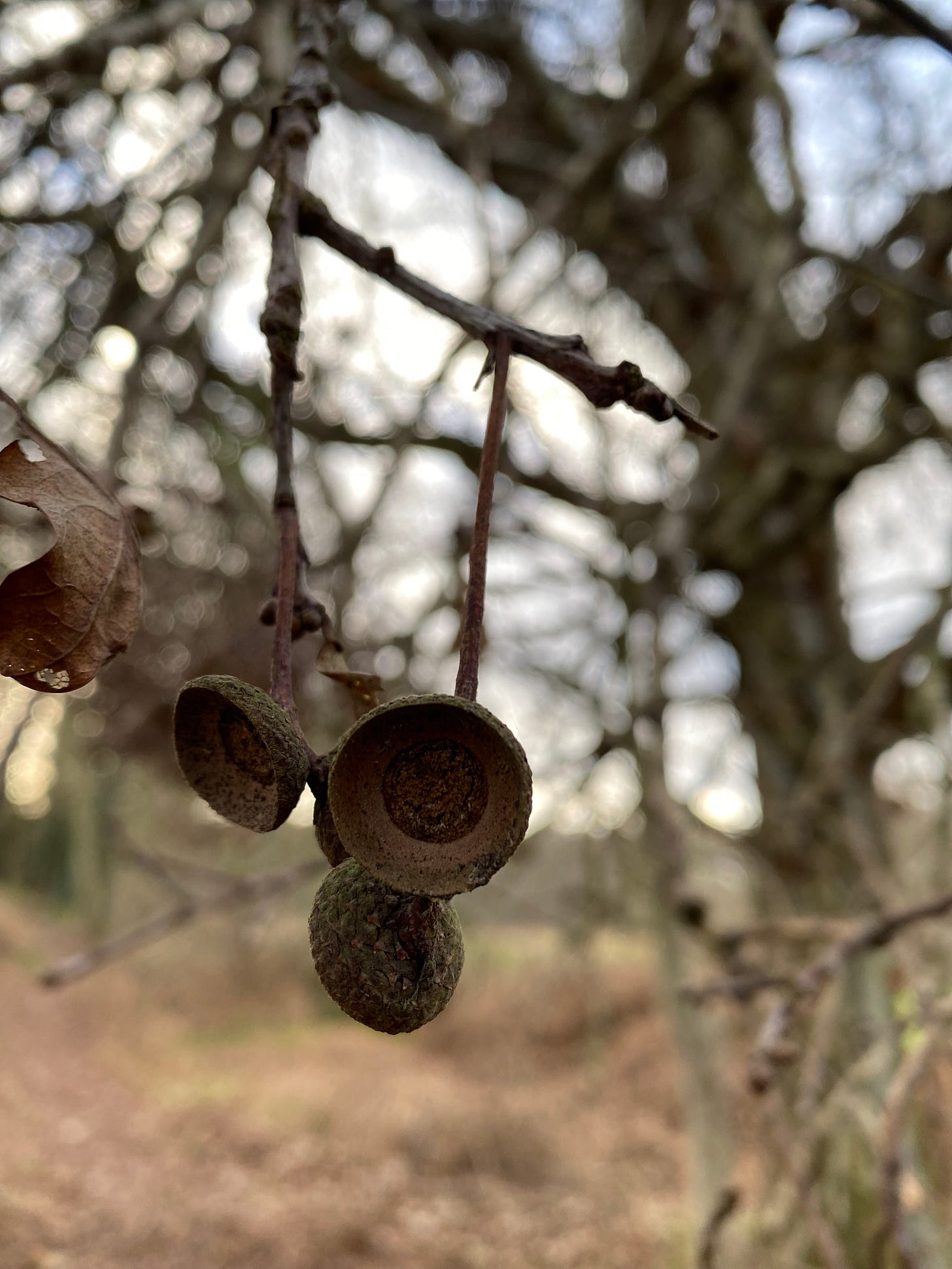

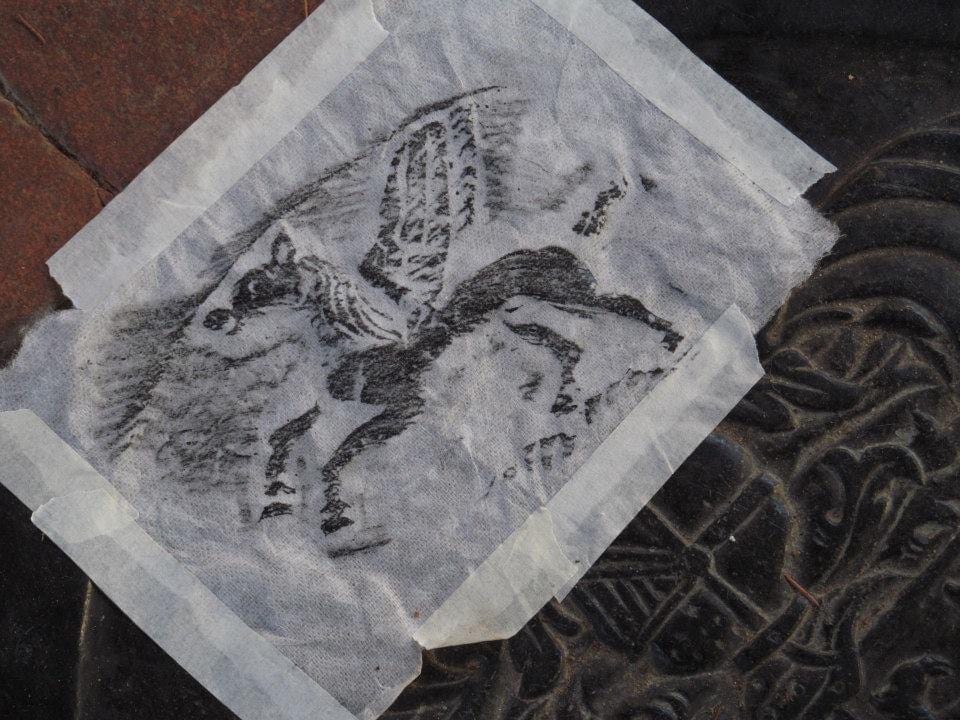
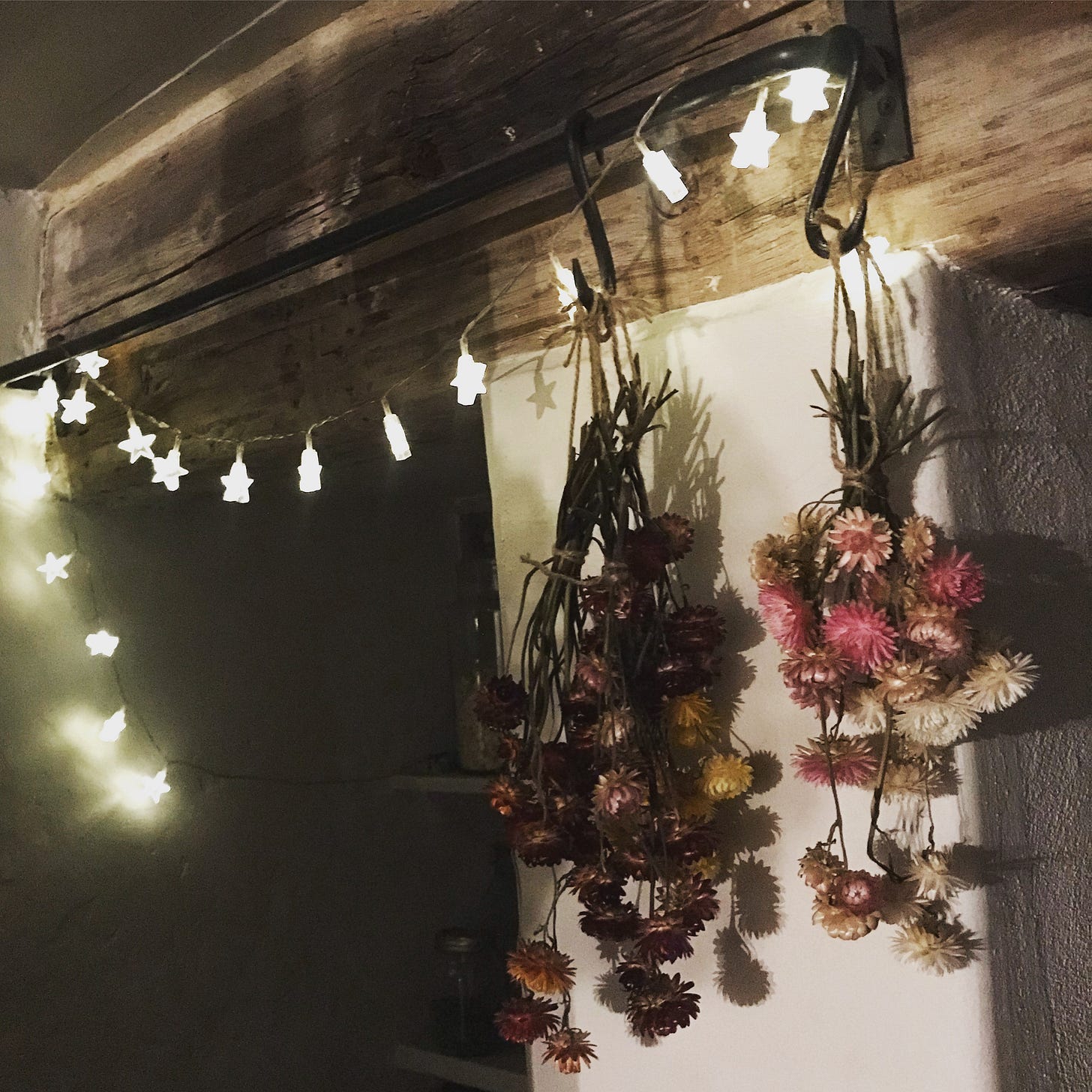



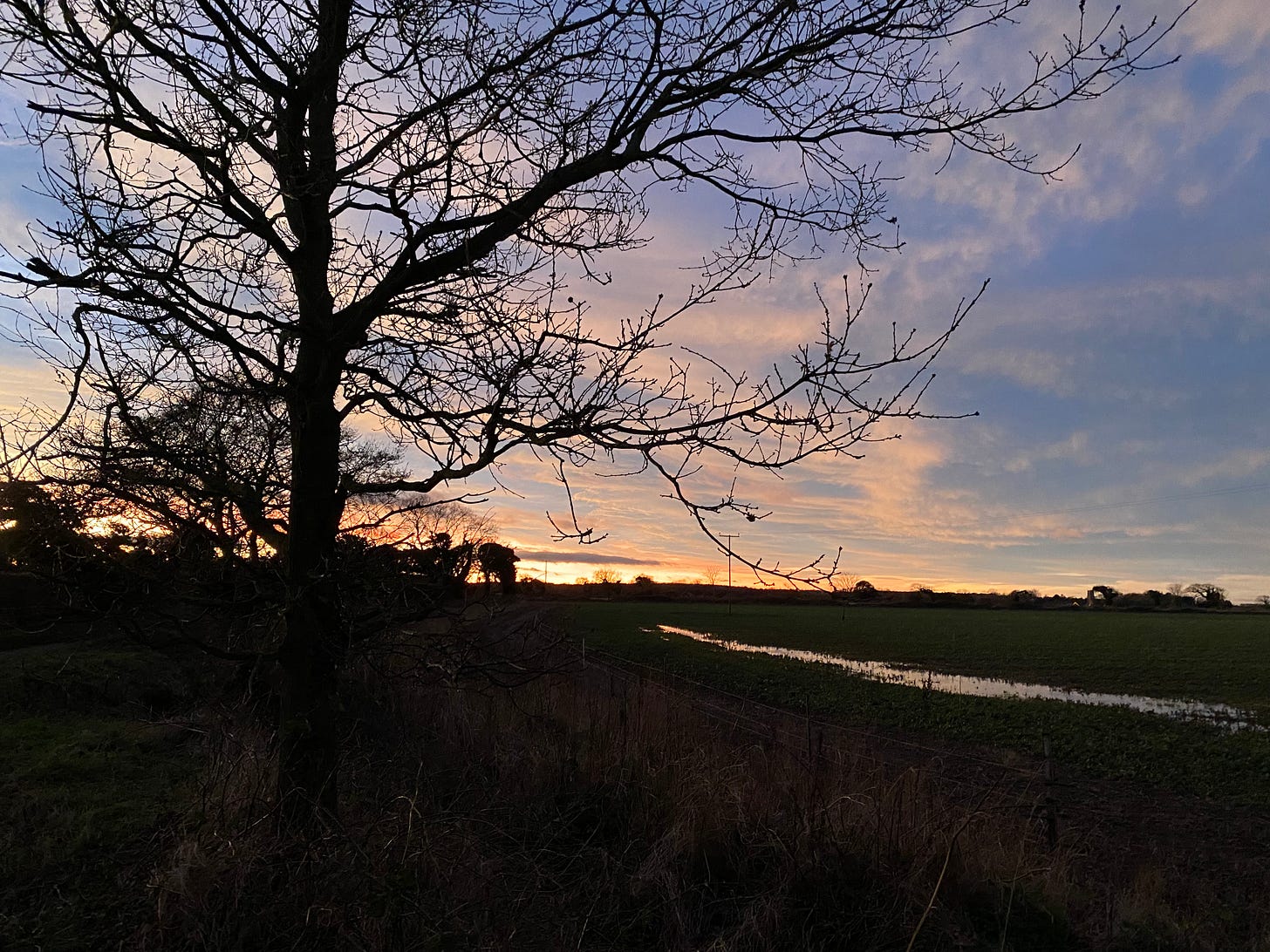
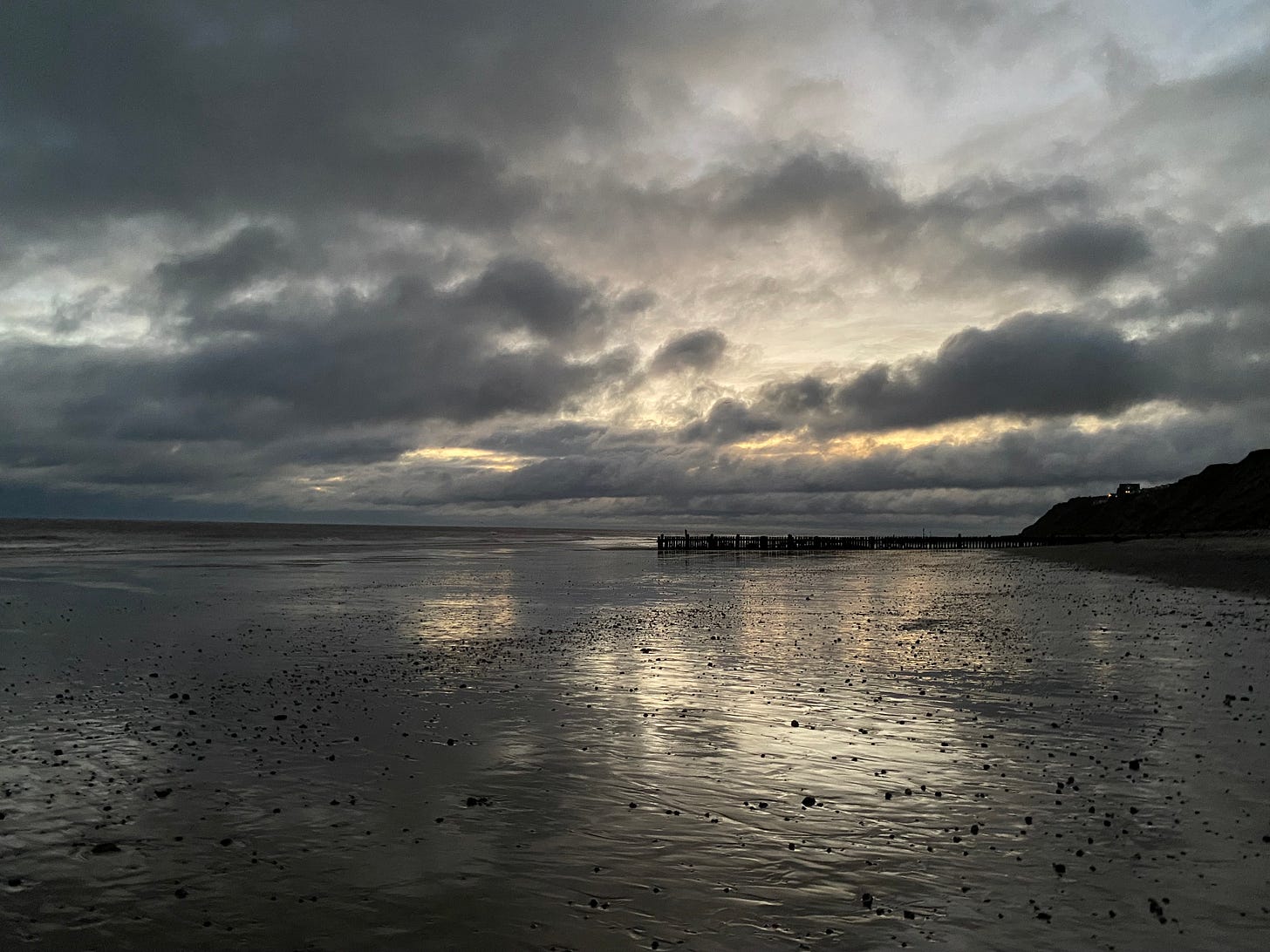
I’m going to make some of the kitchels!
Who would have thought finding a water source would have me on the edge of my seat? I was quite invested in this adventure! Connecting with the land and water is such a powerful thing.
Of course I had to look up more about Kitchels, which sent me down a culinary rabbit hole ( to my delight as a foodie)
I must confess I was at the time snacking on Panpepato, an Italian Christmas delight I made for the first time the other day, a “cake” made from soaked raisins and peel and nuts and chocolate , held together by honey and flour!
Thank you for the Wander, with my jeans feeling a little damp sitting waiting for the sun to set and the flask to empty. 😉